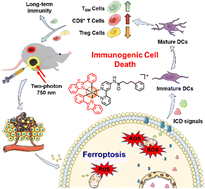A mitochondria-localized iridium(iii) photosensitizer for two-photon photodynamic immunotherapy against melanoma†
Abstract
Conventional photodynamic therapy mainly causes a therapeutic effect on the primary tumor through the localized generation of reactive oxygen species, while metastatic tumors remain poorly affected. Complementary immunotherapy is effective in eliminating small, non-localized tumors distributed across multiple organs. Here, we report the Ir(III) complex Ir-pbt-Bpa as a highly potent immunogenic cell death inducing photosensitizer for two-photon photodynamic immunotherapy against melanoma. Ir-pbt-Bpa can produce singlet oxygen and superoxide anion radicals upon light irradiation, causing cell death by a combination of ferroptosis and immunogenic cell death. In a mouse model with two physically separated melanoma tumors, although only one of the primary tumors was irradiated, a strong tumor reduction of both tumors was observed. Upon irradiation, Ir-pbt-Bpa not only induced the immune response of CD8+ T cells and the depletion of regulatory T cells, but also caused an increase in the number of the effector memory T cells to achieve long-term anti-tumor immunity.

- This article is part of the themed collections: Peripheral immune tolerance: Celebrating the 2025 Nobel Prize in Physiology/Medicine, Spotlight Collection: Bioinorganic Chemistry, Most popular 2023 inorganic chemistry articles and Most popular 2023 chemical biology articles


 Please wait while we load your content...
Please wait while we load your content...